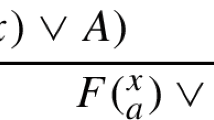Abstract
This work aims at explaining the syntactical properties of continuous normalization, as introduced in proof theory by Mints, and further studied by Ruckert, Buchholz and Schwichtenberg. In an extension of the untyped coinductive λ-calculus by void construcors (so-called repetition rules), a primitive recursive normalization function is defined. Compared with other formulations of continuous normalization, this definition is much simpler and therefore suitable for analysis in a coalgebraic setting. It is shown to be continuous w.r.t. the natural topology on non-wellfounded terms with the identity as modulus of continuity. The number of repetition rules is locally related to the number of β-reductions necessary to reach the normal form (as represented by the Böhm tree) and the number of applications appearing in this normal form.
Supported by the “Graduiertenkolleg Logik in der Informatik” of the Deutsche Forschungsgemeinschaft
Access this chapter
Tax calculation will be finalised at checkout
Purchases are for personal use only
Preview
Unable to display preview. Download preview PDF.
Similar content being viewed by others
References
A. Beraducci and Corrado Böhm. General recursion on second order term algebras. In Rewriting Techniques and Applications, volume 2051 of Lecuture notes in Computer Science, pages 15–30. Springer, 2001.
N. G. de Bruijn. Lambda calculus notation with nameless dummies, a tool for automatic formula manipulation, with application to the Church-Rosser theorem. Indagationes Mathematicae, 34:381–392, 1972.
Wilfried Buchholz. Notation systems for infinitary derivations. Archive for Mathematical Logic, 30:277–296, 1991.
Thierry Coquand. Infinite objects in type theory. In H. Barendregt and T. Nipkow, editors, Proc. 1 st Types 1993 (Nijmengen), volume 806 of Lecture Notes in Computer Science, pages 62–78. Springer, 1994. Available from http://www.cs.chalmers.se/coquand/.
Marcelo Fiore, Gordon Plotkin, and Daniele Turi. Abstract syntax and variable binding (extended abstract). In Proc. 14 th LICS 1999 (Trento), pages 193–202. IEEE Computer Science Press, 1999. Available from http://www.dcs.ed.ac.uk/home/gdp/publications/.
Eduardo Gimenez. Codifying guarded definitions with recursive schemes. In J. Smith, B. Nordström, and P. Dybjer, editors, Proc. Types’94 (Bastad), volume 996 of Lecture Notes in Computer Science, pages 35–59. Springer, 1995. Available from http://pauillac.inria.fr/~gimenez/papers.html.
Felix Joachimski. Confluence of the coinductive lambda-calculus. Submitted to Theoretical Computer Science, available from http://www.mathematik.uni-muenchen.de/~joachski, September 2001.
Felix Joachimski. Reduction Properties of DIE-Systems. PhD thesis, LMU München, 2001. Available from http://www.mathematik.uni-muenchen.de/~joachski.
Richard Kennaway, Jan-Willem Klop, Ronan Sleep, and Fer-Jan de Vries. Infinitary lambda calculus. Theoretical Computer Science, 175(1):93–125, 1997. Available from http://www.sys.uea.ac.uk/~jrk/.
G. Kreisel, G.E. Mints, and S.G. Simpson. The use of abstract language in elementary metamathematics: Some pedagogic examples. In R. Parikh, editor, Logic Colloquium, volume 453 of Lecture Notes in Mathematics, pages 38–131. Springer, 1975.
Grigori E. Mints. Finite investigations of transfinite derivations. Journal of Soviet Mathematics, 10:548–596, 1978. Translated from: Zap. Nauchn. Semin. LOMI 49 (1975). Cited after Grigori Mints. Selected papers in Proof Theory. Studies in Proof Theory. Bibliopolis, 1992.
Martin Ruckert. Church-Rosser Theorem und Normalisierung für Termkalküle mit unendlichen Termen unter Einschluβ permutativer Reduktionen. PhD thesis, Mathematisches Institut der LMU München, 1985.
Helmut Schwichtenberg. Finite notations for infinite terms. Annals of Pure and Applied Logic, 94:201–222, 1998. Available from http://www.mathematik.uni-muenchen.de/~schwicht.
Alastair Telford and David Turner. Ensuring Streams Flow. In Michael Johnson, editor, Proc. 6 th AMAST 1997 (Sydney), volume 1349 of Lecture Notes in Computer Science, pages 509–523. Springer, 1997. Available from http://www.cs.ukc.ac.uk/people/staff/ajt/.
Author information
Authors and Affiliations
Editor information
Editors and Affiliations
Rights and permissions
Copyright information
© 2002 Springer-Verlag Berlin Heidelberg
About this paper
Cite this paper
Aehlig, K., Joachimski, F. (2002). On Continuous Normalization. In: Bradfield, J. (eds) Computer Science Logic. CSL 2002. Lecture Notes in Computer Science, vol 2471. Springer, Berlin, Heidelberg. https://doi.org/10.1007/3-540-45793-3_5
Download citation
DOI: https://doi.org/10.1007/3-540-45793-3_5
Published:
Publisher Name: Springer, Berlin, Heidelberg
Print ISBN: 978-3-540-44240-0
Online ISBN: 978-3-540-45793-0
eBook Packages: Springer Book Archive




